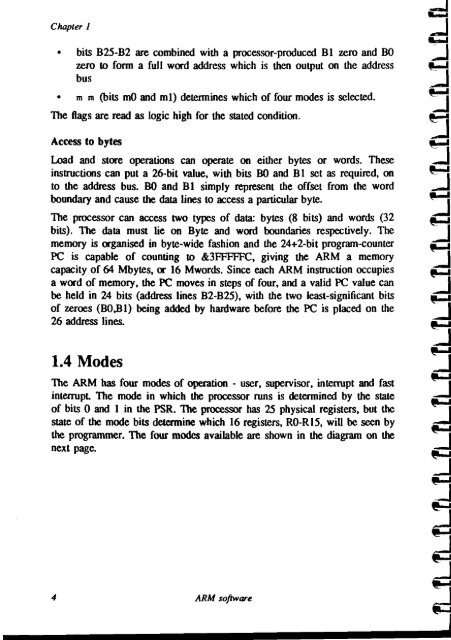ARM Software reference manual
ARM Software reference manual
ARM Software reference manual
You also want an ePaper? Increase the reach of your titles
YUMPU automatically turns print PDFs into web optimized ePapers that Google loves.
Chapter 1<br />
bits B25-B2 are combined with a processor-produced B1 zero and B0<br />
zero to form a full word address which is then output on the address<br />
bus<br />
m m (bits m0 and ml) determines which of four modes is selected.<br />
The flags are read as logic high for the stated condition.<br />
Access to bytes<br />
Load and store operations can operate on either bytes or words. These<br />
instructions can put a 26-bit value, with bits B0 and B I set as required, on<br />
to the address bus. B0 and B1 simply represent the offset from the word<br />
boundary and cause the data lines to access a particular byte.<br />
The processor can access two types of data: bytes (8 bits) and words (32<br />
bits). The data must lie on Byte and word boundaries respectively. The<br />
memory is organised in byte-wide fashion and the 24+2-bit program-counter<br />
PC is capable of counting to &3FFFFFC, giving the <strong>ARM</strong> a memory<br />
capacity of 64 Mbytes, or 16 Mwords. Since each <strong>ARM</strong> instruction occupies<br />
a word of memory, the PC moves in steps of four, and a valid PC value can<br />
be held in 24 bits (address lines B2-B25), with the two least-significant bits<br />
of zeroes (B0,B1) being added by hardware before the PC is placed on the<br />
26 address lines.<br />
1.4 Modes<br />
The <strong>ARM</strong> has four modes of operation - user, supervisor, interrupt and fast<br />
interrupt. The mode in which the processor runs is determined by the state<br />
of bits 0 and 1 in the PSR. The processor has 25 physical registers, but the<br />
state of the mode bits determine which 16 registers, R0-R15, will be seen by<br />
the programmer. The four modes available are shown in the diagram on the<br />
next page.<br />
4 <strong>ARM</strong> software
















